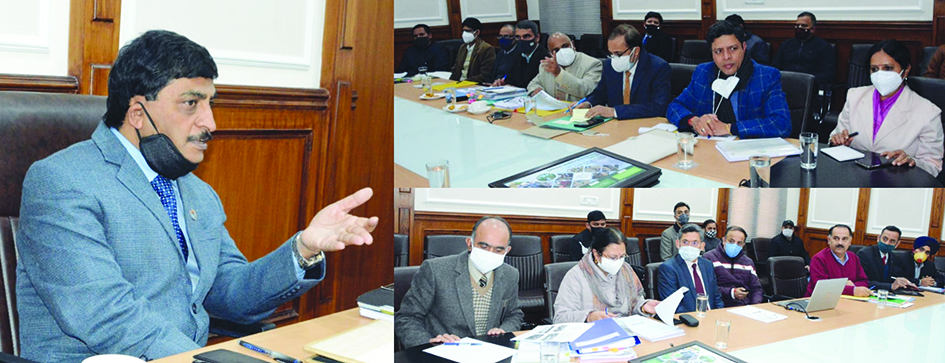 Early Times Report Early Times Report
JAMMU, Dec 21: The Chief Secretary, Dr. Arun Kumar Mehta today chaired a meeting to review the functioning of various wings of the Forest, Ecology & Environment Department.
Commissioner/Secretary, Forest, Ecology & Environment Department along with Principal Chief Conservator of Forest, Director, Ecology, Environment & Remote Sensing, Chairman and Member Secretary, Pollution Control Board (PCB), and concerned HoDs participated in the meeting.
It was informed that under Har Gaon Haryali, the Department has covered 1679 panchayats and distributed 20.68 lakh plants and 18.27 lakh seed balls/ patch sowing grass slips.
Towards promoting eco-tourism in Jammu and Kashmir, the Department has developed various facilities including walking trails, camping sites, and directional/ informational signage at Bangus, Kiterdhagi, Reshwari, Badrakali, Venkura, and Rosi-Gali, among others. Meanwhile, the Department has also opened up 49 forest huts for tourists and operationalized 20 eco-trails across Jammu and Kashmir.
The Department is also dedicatedly pursuing the development of the City Biodiversity Index, Local Biodiversity Strategy, and Action Plan for Jammu and Srinagar cities.
Under the Green India Mission, which is being implemented in the Union territory for the first time, the Department will work towards increasing forest cover and improving ecosystem services including biodiversity conservation, hydrological services, and carbon sequestration. Besides, forest-based livelihood income will also be boosted and alternate fuel energy will be provided to 10,000 households. The Mission will be implemented at an estimated cost of Rs. 372.22 crore and will cover 32,420 Ha of land. Dr Mehta asked the forest deptt to ensure convergence between forest management committee, biodiversity management committee and panchayat plantation committees.
The Forest Department has proactively taken up fire prevention and management by establishing 246 fire control rooms, toll-free helpline(1800-180-7181), developing Pahredar mobile app, and taking timely mitigation measures including the creation of fire lines, water sources, tool & equipment, joint control rooms, awareness creation, and mock drills. The Department has also compiled and released various forest fire vulnerable studies namely – Manual on Prevention & Control of Forest Fires in J&K-2021; Forest Fire Vulnerability Mapping of J&K-2021; and Forest Fire Risk Zonation and Vulnerability Assessment of Forests of Jammu & Kashmir-2021.
So far, the Department has treated 4296.70 hectares of area, installed 30.36 lakh rft fencing, planted 10.24 lakh saplings, and produced 3.28 lakh plants in nurseries. Additionally, the Department has also treated 5709.08 hectares of area by planting 35.47 plants under the Green JK Drive, 2021-22.
Further, the Department of Wildlife Protection is developing the J&K’s first full-fledged Zoo at an estimated cost of Rs. 62.41 crore at Nagrota, Jammu, besides implementing a mitigation plan for Kishtwar High Altitude National Park and undertaking population estimating exercises for Hangul, Waterbirds, and Snow Leopard. The Chief Secretary directed the Forest Department to enhance forest-based livelihood by generating 5 crore mandays employment in convergence with the Rural Development Department, Jal Shakti Department, Agriculture and allied departments, and Mission Youth. Dr. Mehta emphasized proper conservation and management of all 650 wetlands of Jammu and Kashmir and greater integration of different wings of the Department including Forest, Soil Conservation, Wildlife, Pollution Control Board (PCB), and Social Forestry.
The Chief Secretary further directed the Forest Department to activate Village Panchayat Plantation Committees in all 4290 Panchayats and promote monthly dialogues to evolve region-specific sustainable development models.
To ensure widespread people’s participation in government initiatives, the Department was also asked to adopt a multi-disciplinary convergence model, linking school-level eco clubs, Village Panchayat Plantation Committees, and MGNREGA works to various plantation and protection drives.
Further, the Forest Department was asked to evolve a strategy for phased rehabilitation of degraded forest land and fallow land through community participation and ownership. The Department was also asked to expedite the preparation of the City Biodiversity Index, Local Biodiversity Strategy, and Action Plan for the twin capital cities.
The Soil and Water Conservation Department was directed to undertake extensive afforestation of the catchment areas of the water resources being developed under the Jal Jeevan Mission for maintaining a healthy water cycle and promoting natural recharge of both surface and underground water.
Emphasizing the need to keep pollution within the prescribed limits, the PCB was directed to tighten its surveillance especially of the polluting industries like tanneries, brick kilns, cement, and pesticides. |
